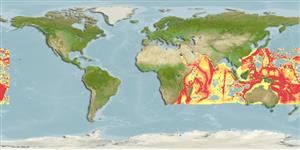Actinopterygii (ray-finned fishes) >
Perciformes (Perch-likes) >
Blenniidae (Combtooth blennies) > Blenniinae
Etymology: Xiphasia: Greek, xiphos = sword (Ref. 45335).
Environment / Climate / Range
Ecology
Marine; benthopelagic; depth range 0 - 4960 m (Ref. 40919). Deep-water, preferred ?; 32°N - 35°S, 18°E - 169°W
Indo-Pacific: Red Sea to Samoa and Ellice Islands, north to Japan, south to Lord Howe Island; Mariana Islands in Micronesia. Southeast Atlantic: False Bay, South Africa (Ref. 4404).
Size / Weight / Age
Maturity: Lm ? range ? - ? cm
Max length : 30.0 cm SL male/unsexed; (Ref. 1602)
Adults inhabit deep waters but rises to the surface at night. Rare species (Ref. 559). They live in tubes in fine sand or mud and rise to the surface at night where they fall prey to pelagic fishes (Ref. 37816). Oviparous. Eggs are demersal and adhesive (Ref. 205), and are attached to the substrate via a filamentous, adhesive pad or pedestal (Ref. 94114). Larvae are planktonic, often found in shallow, coastal waters (Ref. 94114).
Life cycle and mating behavior
Maturity | Reproduction | Spawning | Eggs | Fecundity | Larvae
Oviparous, distinct pairing (Ref. 205).
Myers, R.F., 1991. Micronesian reef fishes. Second Ed. Coral Graphics, Barrigada, Guam. 298 p. (Ref. 1602)
IUCN Red List Status (Ref. 115185)
CITES (Ref. 94142)
Not Evaluated
Threat to humans
Harmless
Human uses
More information
ReferencesAquacultureAquaculture profileStrainsGeneticsAllele frequenciesHeritabilityDiseasesProcessingMass conversion
Tools
Special reports
Download XML
Internet sources
